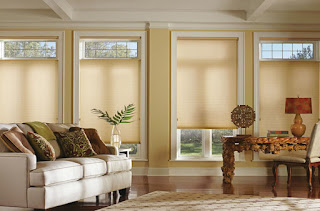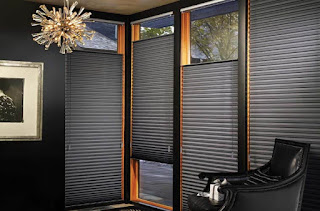Concern for our environment is certainly a growing concern.
But, hitting the house more directly, for many families, is the constant
increase in energy costs. If you live in a cold climate, you probably feel the
pinch of rising fuel costs. I lived in New Hampshire for many years and knew it
very well. It seemed that every winter prices kept going up. But it's not just
climates and cold seasons where rising energy costs are a problem. Cooling your
home is also more expensive.
There are ways to significantly improve the energy efficiency
of your home and one of them is with the right types of shutters and blinds.
One of the best types of window treatments for insulation are cellular blinds,
also called cellular blinds and honeycomb blinds. They come in single, double,
and triple cells. Triple honeycomb blinds provide the highest level of insulation
for hot and cold climates.
There Are Other Options Many types of window treatments and
coatings now offer significant energy efficiency, so you don't have to choose
just one option. For example, blinds and blinds manufacturers may offer
insulated Roman blinds. It's usually an option that adds to the style you
choose, but some come from the factory that way.
 |
| Honeycomb Blinds |
Another option, for those who want the benefits of cellular
blinds, but the appearance of drapery fabrics, should consider insulating Roman
blinds. Blinds are also called panel blinds and sliding window panels. Panel
blinds have fabric panels overlapping on a roller track system, somewhat
similar to vertical blinds.
Another idea is to maximize the heat of the sun with sun
shadows or transparent shades. With these blinds, you can use natural light
during the day. Most shutters and transparent blinds provide the privacy you
want while allowing sunlight to warm the interior of your room.
In addition to energy-efficient cellular blinds, Roman
blinds, or panel blinds, you can also insulate your home using weather
stripping to seal windows and doors. Also, try putting foam blockers behind the
electrical covers. You can also use insulation to wrap your water heater and
water pipes, preventing heat loss during transfer.
When I talk about energy efficiency, I remind you that one of
the simplest things you can do to save energy is to replace your normal light
bulbs with compact fluorescent light bulbs (CFLs). Compact fluorescent bulbs
will last up to ten times longer than regular bulbs while using only 1/4 of
the energy! Many manufacturers offer CFLs that are warmer in color and closely
resemble ordinary light bulbs. They can save energy and improve your interior
design style at the same time.
All of these things I mentioned, especially blinds and blinds
are not really cheap. But they will pay in the long run. Sometimes we just
don't have the money to make our homes as efficient as we would like. I
certainly understand this dilemma. If you find yourself in this situation,
consider buying one part at a time, for several months or even years. This is
what I did while living in the Northeast. He lived in one of those old New
England houses with 50 windows. I couldn't buy cell screens for the entire
house at the same time. So I started slowly and bought blinds for the living
room, then the bedrooms, and so on.
It is important to have energy-efficient shutters or blinds,
because higher efficiency equals a lower heating and cooling bill by keeping
your home warm in winter and cool in summer.
 |
| Honeycomb Blinds |
When we talk about energy-efficient window treatments, an
energy-efficient blind is a misnomer because blinds are not really efficient.
The most energy-efficient window treatments are cellular (or honeycomb) blinds.
The reason blinds are energy efficient is that they block airflow, seal the sides, and provide insulation. In terms of airflow, the blinds
are basically solid, while the blinds allow airflow. In terms of sealing on
the sides, cellular blinds fit much more tightly, reducing airflow around the
window. In addition, cellular blinds are honeycomb construction, trapping air, and providing insulation.
The Honeycomb blinds are available in the single, double, or triple
cell. Double and triple cell simply means an extra layer or two of honeycomb
material. Honeycomb blinds offer the highest levels of insulation and energy
efficiency, but at a higher cost. An alternative to cellular blinds are isolated
Roman blinds that feature a certain style.
No comments:
Post a Comment